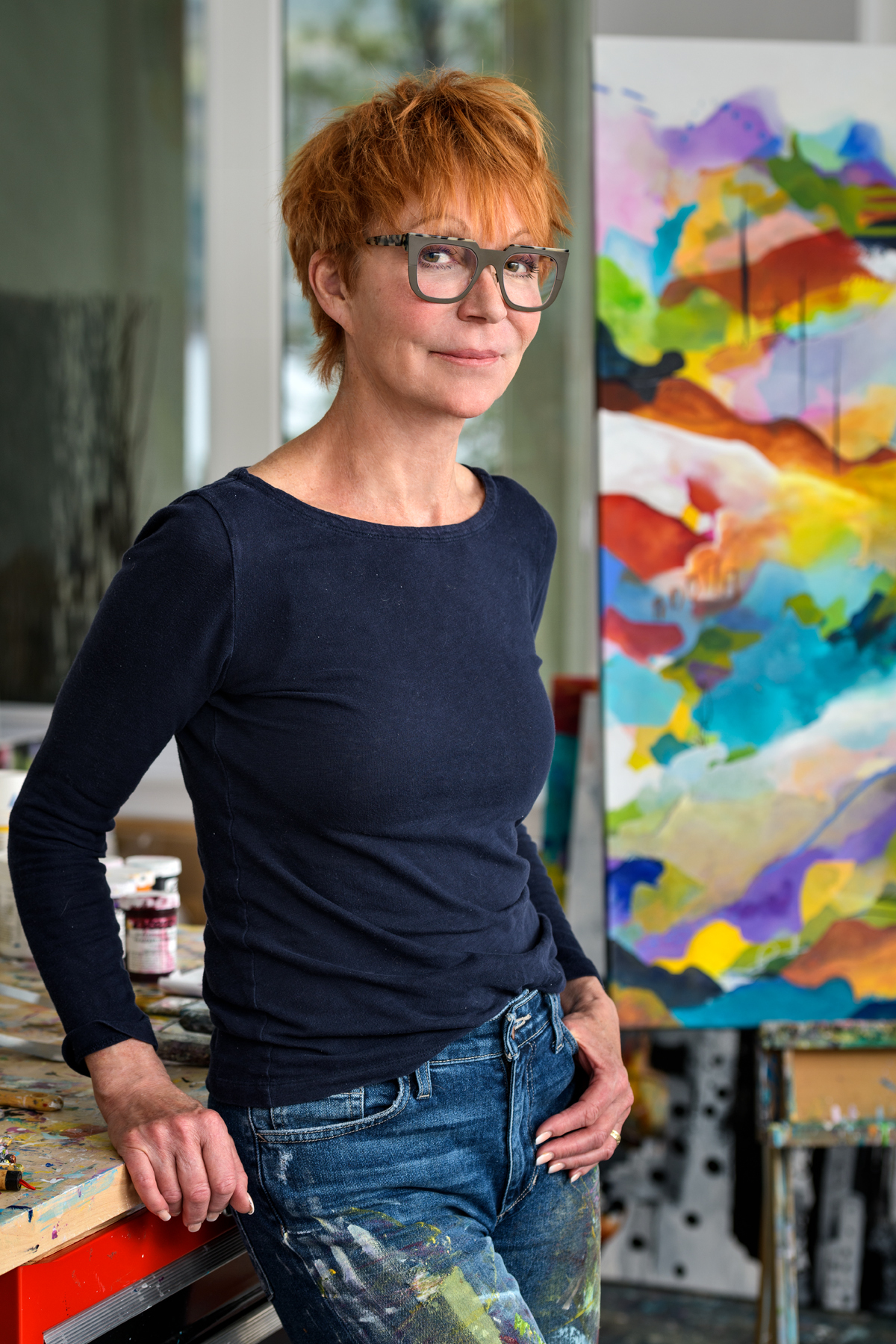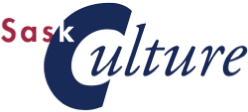Elena Bentley – Hello, Jenny! Welcome. I’m really glad you’re able to meet with me today. I want to jump right in and ask you the first question. Can you talk a little bit about how abstract art brings you in touch with your creative side?
Jenny Lewis – The short version would be: As a child, I was always told to stick to sports because I couldn’t stay in the lines when I was colouring. So, I conformed to that. I went into the corporate world and had my own consulting business for decades. But there was always this pull towards colour. Abstract art taps into, for me, the freedom to express myself. As an artist, you want to know what your why is. Why do you paint? For me, it’s about not conforming to anyone else’s expectations. When I landed on that, I was like oh that’s it, that’s it! Because my whole career to this point, as a consultant in the corporate world, was of course conforming to others’ expectations. There were really good moments, but it’s the freedom. The freedom to go with the flow and see what shows up. I have no idea what’s going to show up in the painting and how it’s going to end up.
EB – Really interesting!
JL – Do I have a plan when I paint? No, typically not. The cityscapes that you selected, as an example, one of your questions was what inspired them. For me, again, it was colour. I saw an image online, years and years ago, and it was a flash and mesh of colours, and I went oh, I love that! What I did, not knowing how they created it, I took dabs of paint and put in little blocks here and shapes here, not anticipating a cityscape, and all of a sudden, I saw the wonky buildings.
EB – I wonder if there was something in the subconscious from your experience in the corporate world. Being in office buildings or downtown in a city.
JL –That’s a good insight. When I was working out of downtown Vancouver, in one of the roles I had before I went out on my own, I was going to the high buildings and being around a lot of different people. I think that’s why I call them my colourful cities. As human beings, we are all so different. We’re so diverse, we all have a different upbringing, we’ve got different tastes. We’re eclectic. I really believe that the cityscapes can represent that.
In the last series that I did, which is the black and white cityscapes, you’ll see a face peeking out. You can imagine what it represents. I put it in there just to see what people will say. It’s not for me to project what this represents, I wouldn’t do that, but I think for the viewer, they can make up their own story.
EB – That’s really interesting. I know the piece you’re talking about and I did notice the face. I also noticed letters and numbers, and even in that black and white one I’m thinking of, there’s little patches of green and blue and pink. It’s kind of a Where’s Waldo? or a seek-and-find of what stands out for you.
JL – Yeah, bang on. The first one in this black and white series was strictly black and white and the different values and greys—I didn’t add any colour. My whole career as an artist was all about colour, and I was starting to miss it, so I did the second one, which has a little bit of rust in the bottom left corner. And the one that you’re referring to, which I think is “Metropolis,” the colour you see is from some art I’ve done on paper. I tore it out and I collaged it in the buildings.
EB – Yes, “Metropolis” is going to be our cover for this issue! I love the bright pink in there, so you’ll see the Grain logo is that nice bright pink, too. I think it’s going to be striking.
The cityscapes will kind of glue the issue together, which is nice. Speaking of these pieces, I can see there must be some other paint or something else put underneath before the paint to create the texture. Maybe this is a good segue, and you can talk us through your process.
JL – Well, I’ll be honest with you, some paintings that I create, I look at and go you know what, it’s just not my favorite. So, all of them have been painted over other paintings. Some of the texture will come from the paints, but I also use different mediums. There’s coarse pumice stone and tar gel. I also use spackle that’s mixed with a medium and then applied typically with a palette knife to give some of that texture. “Metamorphosis” also has small stones from Vancouver Island and glass bead gel. Not all my paintings have mixed media, but a fair number of them do.
EB – Oh, very cool. Can you talk a little bit more about the drive or the feeling—pulling, I think is the verb you used—that pulling to delve into art full-time? Was there a specific moment?
JL – I started late painting. I was in my early fifties, missing the colour. Then I met an artist, Jeanne Krabbendam, and just took a ton of lessons from her. I was painting as a hobby. But I loved it. It was feeding part of my soul that I wasn’t getting in the corporate world. In those days, when I was still working full-time, my office would be on the right and the studio would be over on the left, and I’d have a piece that wasn’t finished on the easel. I would really want to go in there, but I’d have a business deadline.
In 2019, we made the big decision to move from Ocean Park, just south of Vancouver, to Summerland in the Okanagan. We’d been coming to the Okanagan for decades, so we finally made the move here because we were at that stage in our life where we had more flexibility. I was going to transition to thirty percent art and seventy percent consulting. Guess what? COVID kicked in, and it was one hundred percent art. I went, well, okay, I’m going to use this time to learn about the business side of art and focus on my painting.
I just wanted to paint. When I don’t, I get cranky at times. It’s like, I’ve got to get in the studio and I’ve got to do something, even if it’s ugly to begin with. I’d been thinking about making that switch for about seven years before, so it wasn’t an overnight decision.
EB – That’s fantastic. And what I like a lot about these interviews is you’re talking about art, but it’s also applicable to writing or any artistic practice that you want to engage in.
You mentioned that the painting has to get ugly first. Can you talk more about that?
JL – How I go at painting is very random. Typically, what will happen, especially with abstract work, is that you go through a stage in which it looks terrible. I’ve learned from artists who I’ve taken workshops from and who are very accomplished. They say you go through an ugly stage and persevere. What I was doing in my early days of painting is covering it over. Now, I don’t do that anymore because something is going to show up. Something will show up out of the ugly, and then it’s a more deliberate approach to how I finish the painting.
It’s really free initially. I’ll think of some colours and do some colour mixing as well, and then go through it. Step back and look at it. That’s how the Ladies series came up. It was a total mess on the canvas, then I saw a profile—the eye and the nose—and just started working on it and created the first lady’s face. Her name is Irie. All my ladies represent women of strength in their names. No matter what our colour is, no matter what our background is, it doesn’t matter. We’re all beautiful, and that’s why my series is called All Colour is Beautiful. And it came from a really ugly start.
EB – That sounds like good advice for writers, too. You’re not going to write a perfect poem or story right off the bat, but I love that you said persevere. Don’t delete it. Free write, free paint, then go back in. Don’t start from scratch.
JL – I imagine from a writer’s perspective you can go back and do the editing and build on it because there’s good things you started with. It’ll still be there. I think I’d be a lost puppy if I was unable to go out and paint. It’s just who I am now.
EB – I mean, if that’s your vocation, you have to do it.
JL – To be honest, I really didn’t think, at the age I am right now, I would be working full-time. But it is like a full-time job. I go out there and I play pickleball and I do different things, but I put in the hours every week.
You had asked me what advice I would share with other individuals who are thinking of making the switch. For me, there were some key things: one is you have to learn how to paint and you have to do good work. You have to do great work if you want to get it out there. If you’re just doing it for yourself, you can do whatever you want. But if you want to make a living where you get collectors that have your work in their homes, continue to learn and refine the art, whatever that is.
The other thing, and I’m still working on it, is the business side of art. It’s all those skills I used in the corporate world. There’s a whole business side to getting yourself out there as an artist, and it can take a lot of time. There’s a lot of learning, a lot of social media now. I wasn’t a big hound on social media before, but I’ve had to do that because that’s now how people will first see a lot of your art, like how you saw my work on Instagram. We’d never have met if I hadn’t been on Instagram.
EB – You’re right. Probably not.
JL – The great thing about social media is you can be in Saskatchewan, or anywhere in the world, and still have people see your art. If you’re not already on social media, then that’s part of the learning curve and getting set up. Set yourself a schedule, so that you can create in the week. Then you’ve got the marketing or the business side or doing a newsletter to your e-mail list because you want to nurture those relationships with people that love your work. It’s when people know, like, trust you, and love your work, that you start to sell your work.
Another important thing is to have the support from the people who really mean a lot to you in your life: your family, your partner, whoever that is. Because going full-time takes a while, and it’s having that understanding and unconditional support, so that you don’t give up.
I’m in this small group with Jodie King out of Austin, Texas. She’s a great abstract expressionist artist. She’s got over fifty thousand followers on Instagram. She’s an educator for artists as well, and she has a program called Studio Elite. I thought, oh, what the heck! I’ll apply for this, and I was one of five selected for this program. It is a six-month coaching and mentorship program with Jodie. And it is fabulous. We now have this really strong bond, a supportive group to help us.
It’s not easy to make the transition. You have to have that circle because it will support you on the times you want to give up.
EB – That’s great advice. Because there’s a lot of people who will question you. It’s good to have voices in support of your decision.
JL – It takes a lot of courage to go out there and do what we do. You’re going to get a lot of different opinions about what you’re doing for a living and the art you produce. You have to have a thick skin. Another piece of advice, and this is a huge part of the program I’m in with Jodie, is it’s about the mindset as an artist. You have to be really clear about why you’re creating. Know your why because that informs everything else that you do from that point on. And catching that inner dialogue, that negative self-talk that instills doubt. Shut it up, change it, reframe it, and get rid of it
One of the things I use, and I say it to myself every day, is the ‘I am’ statement. As if it’s happening today. Not ‘I want,’ because that infers I’m missing something. “I am an artist in demand. I am producing fabulous artwork,” to counter any negativity coming my way.
EB – I like that lot. You said that you’re expanding the black and white collection, but to wrap up, do you want to talk about what you’re working on, if you have any upcoming events or exhibitions?
JL – Nothing is set. I’ve got some things finishing up. I got excited about the black and white cityscapes. But I also have morphed, again, my art style. I’ve created a few pieces, and the people who have seen them just love it because there’s energy and movement in the paintings. I want to do a series with that kind of feel and look. That’s what I’m going to be focusing on.
I have a few places where I have art in the region. In Penticton, in a gallery called Picture This. In Summerland, where I live, there’s an awesome flower store called Bella Vita, she carries my artwork. And also in the Summerland Art Gallery.
My game plan is to go to the urban centres with the cityscapes and apply to some of the galleries there. In the Okanagan, we’re known for the Okanagan-scape. It’s very popular. A lot of artists create beautiful vineyards and mountains. My art is somewhat different. I’m going to carry on, putting it out there, and leveraging what I create.
EB – That sounds great. A lot of exciting things on the go.
JL – It’s never-ending. I’m so honoured that you selected my work for the summer edition.
EB – You’re very welcome! Thank you for agreeing and accepting, and thank you for this interview. I love chatting with artists and learning how they came to art.
JL – Great. My pleasure.
[This interview has been edited for coherence, clarity, and length.]





